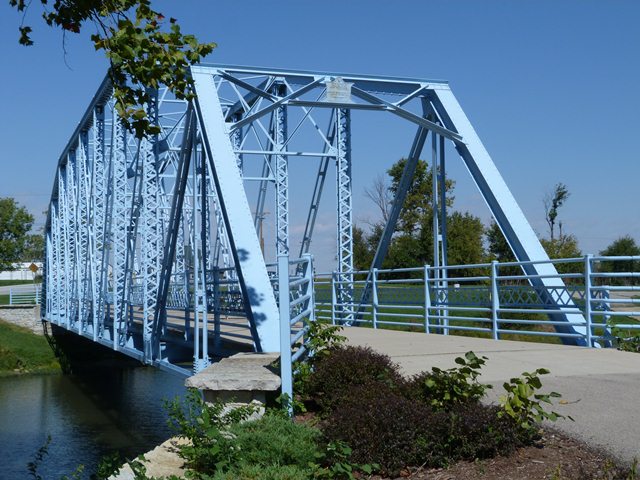We Recommend:
Bach Steel - Experts at historic truss bridge restoration.
BridgeHunter.com Phase 1 is released to the public! - Visit Now
Boyd Bridge
Decatur County Bridge 140

Primary Photographer(s): Nathan Holth and Rick McOmber
Bridge Documented: September 22, 2012
Greensburg: Decatur County, Indiana: United States
1915 By Builder/Contractor: Pan American Bridge Company of New Castle, Indiana and Engineer/Design: Central States Bridge Company of Indianapolis, Indiana
2006
178.2 Feet (54.3 Meters)
180.0 Feet (54.9 Meters)
15.7 Feet (4.79 Meters)
1 Main Span(s)
1600116

View Information About HSR Ratings
Bridge Documentation
View Archived National Bridge Inventory Report - Has Additional Details and Evaluation
This bridge is an uncommon example of a Camelback truss bridge. The bridge was relocated from CR-700 South over Sand Creek to its current location, where it has been restored for pedestrian use in a park setting. The bridge's trusses retain original design and materials. For a bridge of its size, a fair number of firms were involved with its erection. The Central States Bridge Company of Indianapolis apparently submitted a proposal, and while the county adopted their design, they did not hire them to build the bridge. Instead, they had the Burk Construction Company of New Castle become the general contractor for the bridge. The Burk Construction Company in turn had the Pan American Bridge Company of New Castle fabricate the bridge.
Information and Findings From DHPA Historic Bridge SurveyStatement of Significance The only extant Camelback known to have been fabricated by a prolific Indiana firm and one of the oldest riveted structures identified of this truss type, the bridge retains its original members, substructures, and latticed guardrails. Architectural Description The Pan American Bridge Company of Newcastle, Indiana, fabricated this all-riveted truss in 1915. Seated upon its cut stone abutments and wingwalls, the 178'6" span consists of ten panels of approximately 18' each which are separated by laced channel verticals. All diagonals and lower chord members are made of angles riveted to stay plates; none contain turnbuckles. The central section of four panels crosses diagonals in the most central two; diagonals for the other center-section panels and for the two panels per side section stretch toward midspan from the top chord to the bottom. I floor beams, riveted to the gussets and the verticals above the lower chord, support the asphalt-over-concrete deck with a 15'8" roadway and 17' of vertical clearance. Other Information In January 1915, the Decatur commissioners awarded an $7,180 contract for the construction of the Boyd Bridge to the Burk Construction Company of Newcastle. The contract specified that the superstructure was to be fabricated consistent with the plans which the Central States Bridge Company of Indianapolis had submitted with their otherwise unsuccessful proposal. Burk, who worked closely with the Pan American Bridge Company, turned fabrication over to the metal framers of his hometown. Seated upon its cut stone abutments and wingwalls, hip-verticals of a pair of channels and battens and interior ones of laced channels divide each of the all-riveted trusses into 18-foot panels. Diagonals and lower chord members are made of angles riveted to stay plates; none contain turnbuckles. The central section of four panels are counter-braced. At their highest, the trusses carry a height of 29 feet and six inches. The trusses are stiffened with latticed strut frames made from angles, and braced A's at the portals. Angles also supply the upper lateral braces. I floor-beams, riveted to the gussets and the verticals above the lower chord, support the asphalt-over-concrete deck. Latticed railings line the trusses. The county had the bridge repainted in 1919. Bridge Considered Historic By Survey: Yes |
![]()
Photo Galleries and Videos: Boyd Bridge
Bridge Photo-Documentation
Original / Full Size PhotosA collection of overview and detail photos. This gallery offers photos in the highest available resolution and file size in a touch-friendly popup viewer.
Alternatively, Browse Without Using Viewer
![]()
Bridge Photo-Documentation
Mobile Optimized PhotosA collection of overview and detail photos. This gallery features data-friendly, fast-loading photos in a touch-friendly popup viewer.
Alternatively, Browse Without Using Viewer
![]()
Maps and Links: Boyd Bridge
Coordinates (Latitude, Longitude):
Search For Additional Bridge Listings:
Bridgehunter.com: View listed bridges within 0.5 miles (0.8 kilometers) of this bridge.
Bridgehunter.com: View listed bridges within 10 miles (16 kilometers) of this bridge.
Additional Maps:
Google Streetview (If Available)
GeoHack (Additional Links and Coordinates)
Apple Maps (Via DuckDuckGo Search)
Apple Maps (Apple devices only)
Android: Open Location In Your Map or GPS App
Flickr Gallery (Find Nearby Photos)
Wikimedia Commons (Find Nearby Photos)
Directions Via Sygic For Android
Directions Via Sygic For iOS and Android Dolphin Browser
USGS National Map (United States Only)
Historical USGS Topo Maps (United States Only)
Historic Aerials (United States Only)
CalTopo Maps (United States Only)

